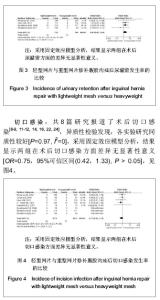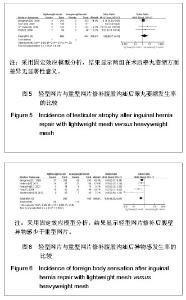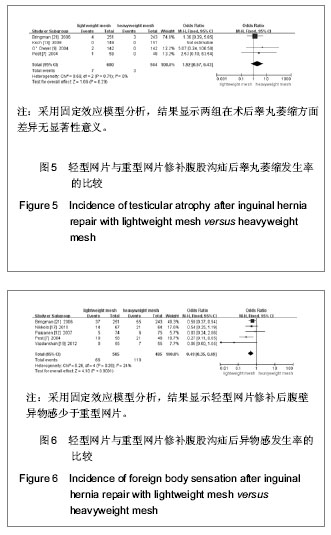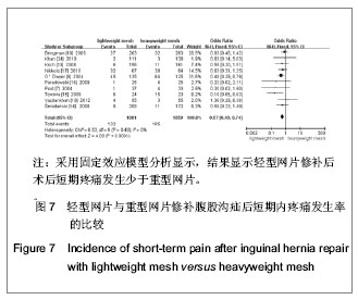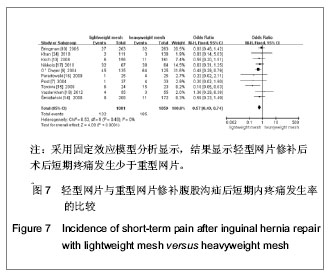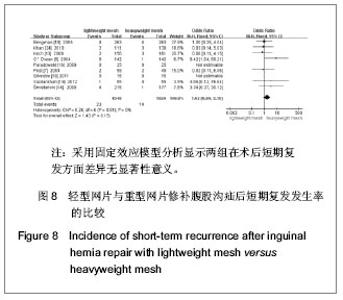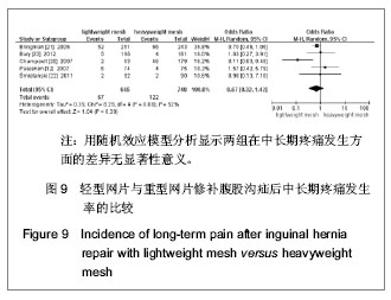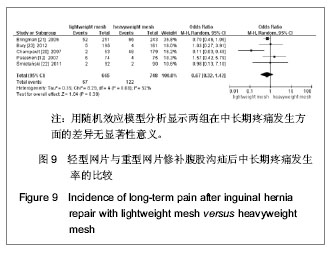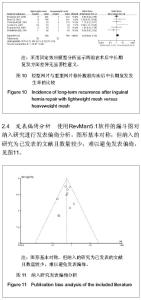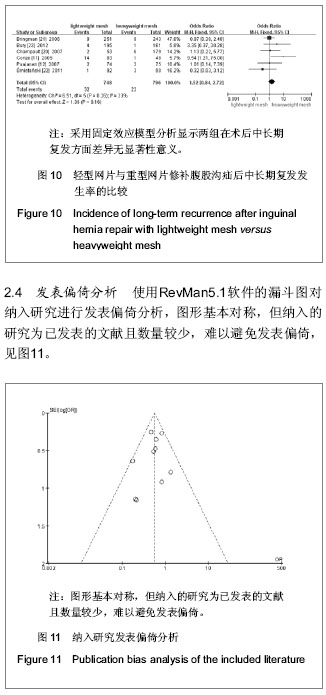Chinese Journal of Tissue Engineering Research ›› 2013, Vol. 17 ›› Issue (47): 8294-8300.doi: 10.3969/j.issn.2095-4344.2013.47.024
The use of lightweight versus heavyweight mesh in open methods of inguinal hernia repair: A meta-analysis
Wang Jia-sheng1, Hu Tie-yi2, Chen Yong2, Yang Qiang1, Li Zhong-fu1
- 1Department of General Surgery, Yong Chuan Hospital, Chongqing Medical University, Chongqing 402160, China; 2Department of ICU, People’s Hospital of Dazu District, Chongqing 402360, China
-
Revised:2013-08-29Online:2013-11-19Published:2013-11-19 -
Contact:Yang Qiang, Professor, Chief physician, Department of General Surgery, Yong Chuan Hospital, Chongqing Medical University, Chongqing 402160, China yq6903@sohu.com -
About author:Wang Jia-sheng★, Studying for master’s degree, Department of General Surgery, Yong Chuan Hospital, Chongqing Medical University, Chongqing 402160, China 252824992@qq.com
CLC Number:
Cite this article
Wang Jia-sheng, Hu Tie-yi, Chen Yong, Yang Qiang, Li Zhong-fu. The use of lightweight versus heavyweight mesh in open methods of inguinal hernia repair: A meta-analysis[J]. Chinese Journal of Tissue Engineering Research, 2013, 17(47): 8294-8300.
share this article
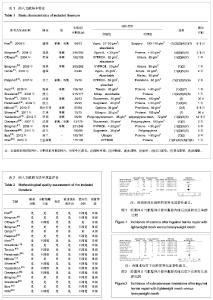
2.1 文献检索和筛选结果 最初检索到相关文献706篇,阅读标题和摘要后筛选到可能符合纳入标准的83篇。进一步仔细读全文后,最后纳入18篇随机对照试验[7-24],全为英文文献,共4 450例腹股沟疝,其中轻型组为2 214例,重型组为2 098例。纳入文献的基本特征见表1。 2.2 方法学质量评价 纳入文献[7-24]全都属于随机对照试验,为计算机随机及数字发生器随机,其中文献[7-8, 10-14, 17, 21-23]对分配隐藏方案进行了描述。文献都采用了盲法,也对失访患者进行了描述,但除文献[9-10]外其他文献未进行意向性分析,详见表2。 2.3 Meta分析结果 血清肿:4篇文献报道了术后血清肿[7-8, 11,24],异质性检验发现,各实验之间同质性较好[P=0.83,I2=0]。采用固定效应模型经行合并,结果显示轻型组与重型组形成血清肿比较差异无显著性意义[OR=0.79,95%可信区间(0.49,1.27),P < 0.05],见图1。 血肿:7篇文献报道了术后皮下血肿[7-8, 11-12, 14, 19, 24],其同质性好[P=0.69,I2=0],采用固定效应模型分后显示,两组术后皮下血肿差异无显著性意义[OR=0.94,95%可信区间(0.59,1.51),P > 0.05],见图2。"
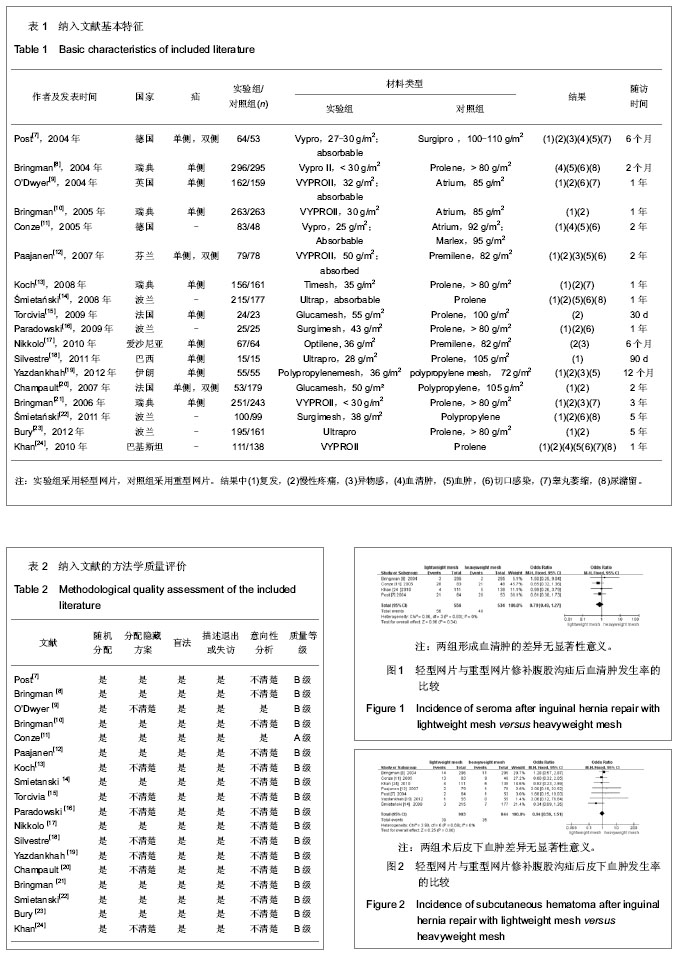
| [1] Lichtenstein IL,Shulman AG,Amid PK,et al.The tension-free hernioplasty.Am J Surg.1989;157(2): 188-193. [2] Bay-Nielsen M,Perkins FM,Kehlet H,et al.Pain and functional impairment 1 year after inguinal herniorrhaphy: a nationwide questionnaire study.Ann Surg.2001;233(1):1-7.
[3] Nienhuijs S,Staal E,Strobbe L,et al.Chronic pain after mesh repair of inguinal hernia: a systematic review.Am J Surg.2007; 194(3):394-400.
[4] Rutkow IM,Robbins AW.Demographic, classificatory, and socioeconomic aspects of hernia repair in the United States .Surg Clin North Am.1993; 73(3):413-426.
[5] Weyhe D,Belyaev O,Muller C,et al.Improving outcomes in herniarepair by the use of light meshes: a comparison of differentimplant constructions based on a critical appraisal of the literature. World J Surg.2007; 31(1):234-244.
[6] Bowne WB,Morgenthal CB,Castro AE,et al.The role of endoscopic extraperitoneal herniorrhaphy: where do we stand in 2005?Surg Endosc.2007;21(5):707-712.
[7] Post S,Weiss B,Willer M,et al.Randomized clinical trial of lightweight composite mesh for Lichtenstein inguinal hernia repair.Br J Surg. 2004;91(1):44-48.
[8] Bringman S,Heikkinen TJ,Wollert S,et al.Early results of a single-blinded, randomized, controlled, Internet-based multicenter trial comparing Prolene and Vypro II mesh in Lichtenstein hernioplasty.Hernia.2004;8(2): 127-134.
[9] O'Dwyer PJ,Kingsnorth AN,Molloy RG,et al.Randomized clinical trial assessing impact of a lightweight or heavyweight mesh on chronic pain after inguinal hernia repair. Br J Surg.2005;92(2):166-170.
[10] Bringman S,Wollert S,Osterberg J,et al.One year results of a randomised controlled multi-centre study comparing Prolene and VyproII mesh in Lichtenstein hernioplasty.Hernia.2005; 9(3):223-227.
[11] Conze J,Kingsnorth AN,Flament JB,et al.Randomized clinical trial comparing lightweight composite mesh with polyester or polypropylene mesh for incisional hernia repair.Br J Surg. 2005; 92 (12):1488 -1493
[12] Paajanen H.A single-surgeon randomized trial comparing three composite meshes on chronic pain after Lichtenstein hernia repair in local anesthesia.Hernia.2007;11(4):335-339.
[13] Koch A,Bringman S,Myrelid P,et al.Randomized clinical trial of groin hernia repair with titanium-coated lightweight mesh compared with standard polypropylene mesh.Br J Surg.2008; 95(10):1226-1231.
[14] Polish Hernia Study Group.?mietański M.Randomized clinical trial comparing a polypropylene with a poliglecaprone and polypropylene composite mesh for inguinal hernioplasty.Br J Surg.2008;95(12):14 62-1468.
[15] Torcivia A,Vons C,Barrat C,et al.Influence of mesh type on the quality of early outcomes after inguinal hernia repair in ambulatory setting controlled study: Glucamesh®vs Polypropylene®.Langenbecks Arch Surg.2011;396(2): 173-178.
[16] Paradowski T,Olejarz A,Kontny T,et al.Polypropylene vs. ePTFE vs. WN mesh for Lichtenstein inguinal hernia repair a prospective, randomized, double blind pilot study of one-year follow-up.Videosurgery and other miniinvasive techniques. 2009; 4(1): 6-9.
[17] Nikkolo C,Lepner U,Murruste M,et al.Randomised clinical trial comparing lightweight mesh with heavyweight mesh for inguinal hernioplasty.Hernia.2010;14(3):253-258.
[18] Silvestre AC,De Mathia GB,Fagundes DJ,et al.Shrinkage evaluation of heavyweight and lightweight polypropylene meshes in inguinal hernia repair: a randomized controlled trial.Hernia.2011;15 (6): 629-634.
[19] Yazdankhah Kenary A,Afshin SN,Ahmadi Amoli H,et al.Randomized clinical trial comparing lightweight mesh with heavyweight mesh for primary inguinal hernia repair. Hernia. 2012.[Epub ahead of print]
[20] Champault G,Bernard C,Rizk N ,et al.Inguinal hernia repair: the choice of prosthesis outweighs that of technique.Hernia. 2007; 11(2):125-128.
[21] Bringman S,Wollert S,Osterberg J,et al.Three-year results of a randomized clinical trial of lightweight or standard polypropylene mesh in Lichtenstein repair of primary inguinal hernia.Br J Surg.2006; 93(9):1056-1059.
[22] ?mietański M,Bury K,?mietański IA,et al.Five-year results of a randomised controlled multi-centre study comparing heavy-weight knitted versus low-weight, non-woven polypropylene implants in Lichtenstein hernioplasty.Hernia. 2011; 15(5):495-501.
[23] Bury K,?mietański M,Polish Hernia Study Group.Five-year results of a randomized clinical trial comparing a polypropylene mesh with a poliglecaprone and polypropylene composite mesh for inguinal hernioplasty.Hernia.2012; 16(5):549-553.
[24] Khan N,Bangash A,Sadiq M,et al.Polyglactine/polypropylene mesh vs. propylene mesh: is there a need for newer prosthesis in inguinal hernia? Saudi J Gastroenterol. 2010; 16(1):8-13.
[25] Sajid MS,Leaver C,Baig MK,et al.Systematic review and meta-analysis of the use of lightweight versus heavyweight mesh in open inguinal hernia repair.Br J Surg.2012;99(1): 29-37.
[26] Zhong C,Wu B,Yang ZA,et al.A meta-analysis Comparing Lightweight Meshes With Heavyweight Meshes in Lichtenstein Inguinal Hernia Repair.Surg Innov.2013; 20(1): 24-28.
[27] Gao M,Han J,Tian J,et al.VYPRO II mesh for inguinal hernia repair: a meta-analysis of randomized controlled trials.Ann Surg.2010; 251(5):838-842.
[28] 李俊.无张力疝修补术后慢性腹股沟痛[J].中国实用外科杂志, 2012, 32(6):499-501.
[29] Klinge U,Klosterhalfen B,Müller M,et al.Foreign body reaction to meshes used for the repair of abdominal wall hernias.Eur J Surg.1999; 165:665-673.
[30] 张卫玮,曹润福.经腹腹腔镜与后腹膜腹腔镜根治性肾切除治疗肾癌的Meta分析[J].中国组织工程研究与临床康复,2010, 14(53): 10003-10006. |
| [1] | He Yan-ping, Ma De-chun, Li Lei, Zhang Li, Zheng Shuang, Dong Ke-xin. Hemocompatibility and surface modification of artificial blood vessel materials [J]. Chinese Journal of Tissue Engineering Research, 2015, 19(8): 1272-1276. |
| [2] | Li Bing-ting, Jia Ying-zhen, Liu Zhi-fang, Song Yuan, Hou Xiao-wei. Effect of freeze-dried bone xenograft and platelet-rich fibrin compound on osteogenesis and osseointegration of alveolar bone defects [J]. Chinese Journal of Tissue Engineering Research, 2014, 18(52): 8376-8381. |
| [3] | Wang Xiao-dong, Zhang Yong-hong. Preparation and performance of recombinant human bone morphogenetic protein-2-poly(hydroxybutyrate-co-hydroxyoctanoate) nanospheres [J]. Chinese Journal of Tissue Engineering Research, 2014, 18(52): 8405-8408. |
| [4] | Feng Chao, Li Zhe, Lv Xiang-guo, Xu Yue-min, Fu Qiang. In vitro preparation and biochemical evaluation of oxygen generative keratin/silk fibroin compound biomaterial [J]. Chinese Journal of Tissue Engineering Research, 2014, 18(52): 8480-8486. |
| [5] | Li Tian-shi, Zeng Wen-ni, He Jun-jun. Chitin and its derivatives inhibit scar formation [J]. Chinese Journal of Tissue Engineering Research, 2014, 18(52): 8504-8508. |
| [6] | Ma Song-feng, Cao Hui, Zheng Feng, Qiao Jun, Zhang Guo-ming. Concomitant cardiac valve replacement and coronary artery bypass grafting [J]. Chinese Journal of Tissue Engineering Research, 2014, 18(5): 699-704. |
| [7] | Lu Hua-ding, Lian Li-yi, Chen Ming-wei, Dai Yu-hu. Cloning and expression of Asperguillus endo-chitosanase gene in Escherichia coli [J]. Chinese Journal of Tissue Engineering Research, 2014, 18(34): 5490-5496. |
| [8] | Fan Zhong-bao, Rong Da-qing, Liu Qing-feng. Prolene hernia system versus polypropylene mesh plug in tension-free hernia repair [J]. Chinese Journal of Tissue Engineering Research, 2014, 18(34): 5535-5539. |
| [9] | Li A-li. Absorbable ligating clip in laparoscopic hysterectomy [J]. Chinese Journal of Tissue Engineering Research, 2014, 18(34): 5561-5565. |
| [10] | Huang Xiao-nan. Percutaneous vertebroplasty for treatment of osteoporotic vertebral fractures: high-viscosity versus low-viscosity bone cement [J]. Chinese Journal of Tissue Engineering Research, 2014, 18(16): 2461-2467. |
| [11] | Liu Li-xia, Chen Lin. Comparison of fluoride release and solubility for different glass ionomer cements [J]. Chinese Journal of Tissue Engineering Research, 2014, 18(16): 2480-2486. |
| [12] | Zhou Zheng, Yang Ze-hui, He Hui-yu, Cui Jie. Biocompatibility of freeze-dried antigen-extracted sheep cancellous bone scaffolds [J]. Chinese Journal of Tissue Engineering Research, 2014, 18(16): 2499-2505. |
| [13] | Wang Jin-ning, Pi Bin, Wang Peng, Zhu Xue-song, Yang Hui-lin. Cytocompatibility and cytotoxicity of a novel composite bone cement material composed of chitosan microsphere, alpha-tricalcium phosphate and silk fibroin [J]. Chinese Journal of Tissue Engineering Research, 2014, 18(16): 2519-2525. |
| [14] | Chen Peng, Zhang Jie, Rong Dong-ming, Han Zhong-yu, Yuan Si-jie, Tian Jing. Effects of non-dextran coated superparamagnetic iron oxide nanoparticles on proliferation of bone marrow mesenchymal stem cells [J]. Chinese Journal of Tissue Engineering Research, 2014, 18(16): 2526-2531. |
| [15] | Huang Xie-shan, Liu Ming, Wang Jiang. Preparation and cytocompatibility of cuttlebone-transformed hydroxyapatite [J]. Chinese Journal of Tissue Engineering Research, 2014, 18(16): 2532-2537. |
| Viewed | ||||||
|
Full text |
|
|||||
|
Abstract |
|
|||||
